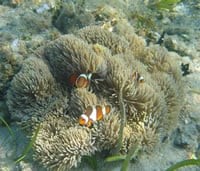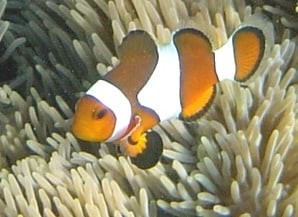Is Naturalist Specialty the art of naked diving?
What do we learn from taking this Specialty?
Do we actually learn any new diving skills from it?
During the Advanced Open Water course you can choose to do a Naturalist dive, and I have often been asked by some either hopeful or worried students, "Does that mean we have to dive naked?" Naturalist Specialty can range from studying the largest fish in the world, the Whale Shark, to experiencing the joys of phosphorescence at night, when microscopic algae light up, creating sparkling dust trails in the dark. Teaching the Naturalist Specialty gives an instructor the chance to promote a sense of conservation and love of the underwater world. All this can be done fully suited up. So no, you do not have to dive naked in order to get this qualification, but you will gain an understanding of the relationships between many marine creatures on the reef, and you will discover why buoyancy control is so important.
 What does the course include? Depending on which organisation you dive with, it can be one or two dives with a good amount of classroom work. It includes an introduction to the local aquatic life, plant and animal names, where they live, and the best time of year to find them. In many areas you can get fish slates (an underwater slate with pictures of local marine animals), which you take on a dive with you to help identify the creatures around you. Also covered are important environmental issues; how to avoid damaging fragile habitats on a grand scale through conservation, as well as on a personal scale with buoyancy control skills. Marine myths, such as ‘all sharks are dangerous’, are dispelled and the basic aquatic life interactions such as symbiosis are discussed.
What does the course include? Depending on which organisation you dive with, it can be one or two dives with a good amount of classroom work. It includes an introduction to the local aquatic life, plant and animal names, where they live, and the best time of year to find them. In many areas you can get fish slates (an underwater slate with pictures of local marine animals), which you take on a dive with you to help identify the creatures around you. Also covered are important environmental issues; how to avoid damaging fragile habitats on a grand scale through conservation, as well as on a personal scale with buoyancy control skills. Marine myths, such as ‘all sharks are dangerous’, are dispelled and the basic aquatic life interactions such as symbiosis are discussed.
So what is symbiosis? It is an ecological interdependence between creatures of two different species. Many of the animals living in and around the coral reefs are in symbiotic relationships and during the naturalist dives, you can see and study these relationships in action. If you have seen ‘Finding Nemo’, you will know that Nemo is a clown fish who lives in an anemone, and that no other fish can live within its stinging tentacles. So that the clown fish can benefit from the anemone’s protection, he eats the anemone’s detritus, thus making the relationship of benefit to both parties.
Other symbioses are the cleaner wrasse, who wait eagerly for a fish with parasites to swim by, when a fish wants a clean it cruises in and lets the wrasse pick off any unwanted yet delicious particles, just like a car wash! Often, I have seen the cleaner wrasse tickling a student by cleaning their ears, or eating away the dead skin around wounds. Another fascinating relationship is where a gobi fish guards a hole that a shrimp digs; this provides the gobi with food and the shrimp with protection.
Responsible passive or active human interactions with the aquatic life is an important part of the Naturalist Specialty. Our diving techniques are crucial in the preservation of marine life, giving the diver a good reason for improving neutral buoyancy skills. It is horrible to watch a diver dragging their fins over corals leaving a trail of destruction behind them, even the most casual contact with the reef can kill it. It is also important to keep dive equipment trim by tucking in gauges and not touching or standing on the reef. This links very well to attending buoyancy workshops, which I strongly recommend and many dive shops do offer. How many times have you seen a new or seasoned diver picking things up and pocketing them, live cowries, sea stars, sponges, to bring back as souvenirs, this has to stop too. The old saying, "Take nothing but photos, leave nothing but bubbles" is a very cheesy line, but it is how we should dive.
 It is an instructor’s responsibility to be an ambassador for the coral reefs, which are among the most fragile and endangered eco-systems on earth. Through industry and pollution, man has done irreversible damage to the underwater environment, endangering many species and promoting extinction. It is estimated that a further 70% of the world’s coral reefs will die within our lifetime if the current rate of destruction is maintained. It is therefore up to divers to promote a sense of preservation of the reefs. On Koh Tao in Thailand, the dive shops have grouped together to put buoy lines on all the dive sites, to try to stop anchor damage. The crash of an anchor can destroy what nature has taken centuries to create. Naturalist Specialty is one way that we can teach divers who enjoy the beauties of the ocean to preserve and protect what lives within it.
It is an instructor’s responsibility to be an ambassador for the coral reefs, which are among the most fragile and endangered eco-systems on earth. Through industry and pollution, man has done irreversible damage to the underwater environment, endangering many species and promoting extinction. It is estimated that a further 70% of the world’s coral reefs will die within our lifetime if the current rate of destruction is maintained. It is therefore up to divers to promote a sense of preservation of the reefs. On Koh Tao in Thailand, the dive shops have grouped together to put buoy lines on all the dive sites, to try to stop anchor damage. The crash of an anchor can destroy what nature has taken centuries to create. Naturalist Specialty is one way that we can teach divers who enjoy the beauties of the ocean to preserve and protect what lives within it.
So now you know that it is not obligatory to dive au natural in order to do the Naturalist Specialty. I am not really too sure I would want to watch my students diving naked, although there have been a couple of handsome young lads that I would merrily deceive. What you do benefit from in taking the Naturalist Specialty is an increased knowledge of local marine life, which stimulates the pleasure of the dive and gives you some good après dive chat. Do we actually learn any diving techniques? Well, I think that the Naturalist Specialty instills the reasons that we should have good diving techniques, and it makes us want to protect and nurture our underwater surroundings by being better divers.
Interesting Websites to visit
http://www.amonline.net.au/explore/researchers_info.htm
http://www.enchantedlearning.com
Good Books
Marine Fishes of Tropical Australia and South-East Asia, by Gerald R.Allen
Micronesian Reef Fishes: A Field Guide for Divers and Aquarists, by Robert F Myers
Indian Ocean Reef Guide, by Helmut Debelius
